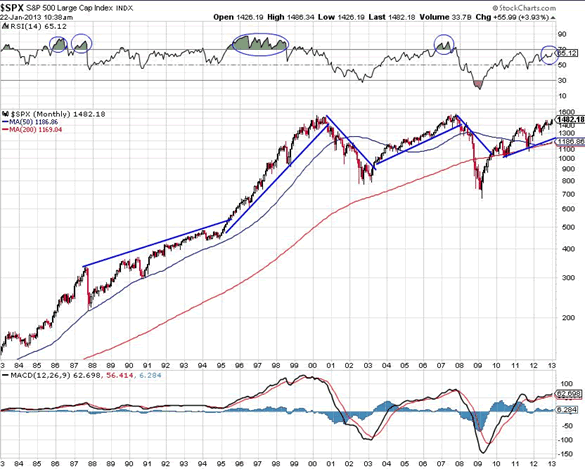Is Your Stocks Portfolio Ready for What’s Going to Happen?
Stock-Markets / Stock Markets 2013 Jan 25, 2013 - 09:13 AM GMT Sasha Cekerevac writes: As corporate earnings season continues for S&P 500 companies, it is becoming quite evident that revenue growth is lacking across many sectors of the economy. However, we are continuing to see growth in corporate earnings per share.
Sasha Cekerevac writes: As corporate earnings season continues for S&P 500 companies, it is becoming quite evident that revenue growth is lacking across many sectors of the economy. However, we are continuing to see growth in corporate earnings per share.
How is this possible? One method is through share buybacks. S&P 500 corporations, which are generating very high levels of cash, are buying back shares and reducing the number outstanding, which increases the corporate earnings-per-share level.
From April 2011 through October 2012, S&P 500 companies bought back and retired approximately eight billion shares, according to FactSet. This has been a significant driver for corporate earnings over the last two years. (Source: Cheng, J., “Investors See a Way Forward: Buybacks,” Wall Street Journal, January 21, 2013.)
If this level of share buybacks for S&P 500 corporations continues this year, we can expect to see corporate earnings increase by between five percent and 10%, without any organic growth in corporate earnings and flat revenues.
Another driver for S&P 500 share prices will be that the dividend yield will still remain very attractive when compared to U.S. Treasuries.
While revenue growth needs to begin to increase substantially at some point, I think 2013 will be another year in which the combination of a strong dividend yield and modest corporate earnings growth will result in the continuation of investment funds rotating out of the bonds and into equities.
Personally, I think a lot of buybacks are ill timed. While I like to see corporate earnings increase, the problem with many S&P 500 companies is that they tend to buy shares at the wrong time.
When the S&P 500 was dropping in late 2008, S&P 500 corporations should have been aggressively buying back shares. When the overall market is up, I would rather have a higher dividend yield and fewer share buybacks.
Instituting share buybacks on significant selloffs is better for the long-term investor, as the company is able to both increase corporate earnings and buy shares at more attractive levels. Buying shares when they’re at very high levels usually isn’t the best use of funds.

Chart courtesy of www.StockCharts.com
Another year of steady, if not spectacular, corporate earnings growth with flat revenues and strong dividend yields would make sense in the overall S&P 500 picture.
Above is a 30-year monthly chart of the S&P 500. Note that when a new uptrend begins, it has generally lasted approximately four years. I would even consider an acceleration, or higher trajectory, in the market a new trend.
The S&P 500 increased its trajectory in late 1995, topping out in 2000. Following the pullback, a new uptrend began in 2003, topping out in 2007. The latest uptrend began in 2010, which, if history is any guide, means that the S&P 500 has one more year before topping out. Of course this is an oversimplification, but it’s worth considering nonetheless.
This very rough timeline also makes sense of how corporate earnings and interest rates will move. If revenues start to decline, this will cause cash flow to deteriorate and result in lower levels of share buybacks, thus lowering corporate earnings.
Also, next year, we will most likely see the Federal Reserve either begin to tighten monetary policy or (at the very least) voice the opinion that a tightening money supply will begin shortly. This will certainly cause panic across all markets.
While corporate earnings can be massaged higher through share buybacks, at some point, revenues need to grow. Revenues for most firms are relatively flat, but they’re also not declining significantly. Flat revenues can still allow decent corporate earnings per share this year through share buybacks; but in an environment of rising interest rates and declining revenues, the S&P 500 could be in a lot of trouble.
Source: http://www.investmentcontrarians.com/recession/this-isnt-just-an-american-dilemma/1300/
By Sasha Cekerevac, BA
www.investmentcontrarians.com
Investment Contrarians is our daily financial e-letter dedicated to helping investors make money by going against the “herd mentality.”
About Author: Sasha Cekerevac, BA Economics with Finance specialization, is a Senior Editor at Lombardi Financial. He worked for CIBC World Markets for several years before moving to a top hedge fund, with assets under management of over $1.0 billion. He has comprehensive knowledge of institutional money flow; how the big funds analyze and execute their trades in the market. With a thorough understanding of both fundamental and technical subjects, Sasha offers a roadmap into how the markets really function and what to look for as an investor. His newsletters provide an experienced perspective on what the big funds are planning and how you can profit from it. He is the editor of several of Lombardi’s popular financial newsletters, including Payload Stocks and Pump & Dump Alert. See Sasha Cekerevac Article Archives
Copyright © 2013 Investment Contrarians - All Rights Reserved Disclaimer: The above is a matter of opinion provided for general information purposes only and is not intended as investment advice. Information and analysis above are derived from sources and utilising methods believed to be reliable, but we cannot accept responsibility for any losses you may incur as a result of this analysis. Individuals should consult with their personal financial advisors.
Investment Contrarians Archive |
© 2005-2022 http://www.MarketOracle.co.uk - The Market Oracle is a FREE Daily Financial Markets Analysis & Forecasting online publication.



